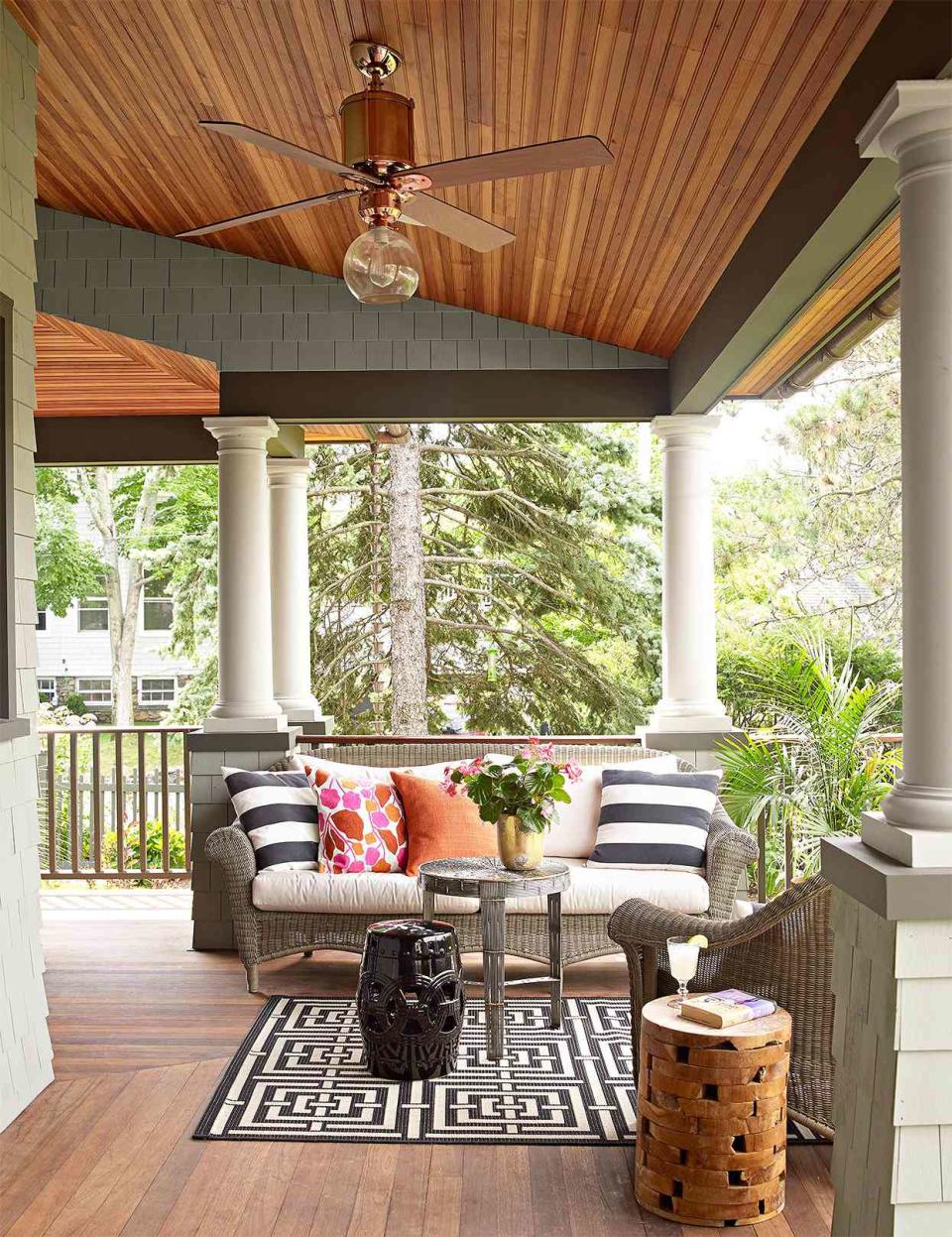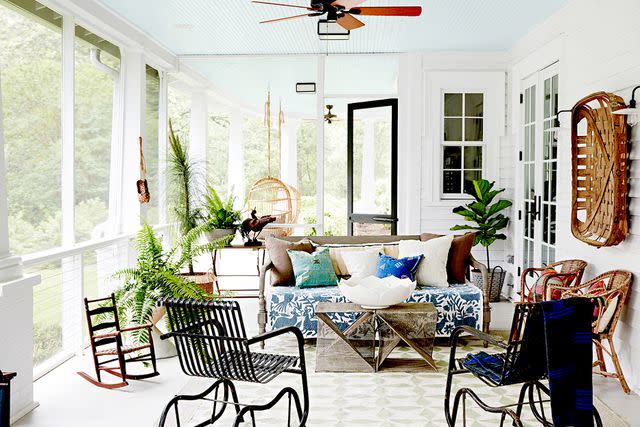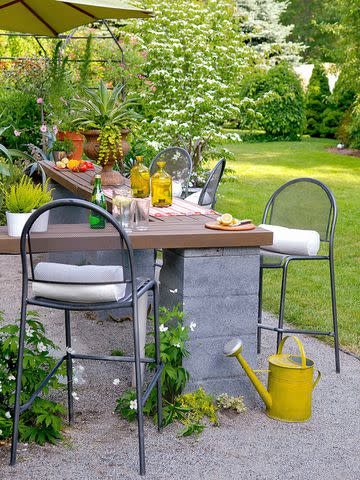Porches and Patios Aren’t the Same Thing—Here’s What Sets Them Apart
Outdoor living spaces are highly sought-after features of any home. Learn the differences between a porch and a patio—plus how each can impact sellability.

More and more, Americans are taking to the outdoors, fine tuning their yards to take advantage of that coveted green. As such, porches and patios—which have always been popular, though not quite to this extent—are increasingly key home features for prospective buyers and home renovators alike.
“Increasing usable space on the property by way of functional outdoor space—either in the form of a porch or a patio—is a way of expanding the square footage of a home,” says Kevin Lenhart, design director at landscape design service Yardzen. “An outdoor space ready for living that doesn’t require a ton of fixing up immediately communicates value beyond the four walls of the home. The American Society of Landscape Architects says homeowners can boost their home’s value by 20% with beautiful and functional landscaping and hardscaping.”
There’s no denying that porches and patios are highly sought-after features—but how do they stack up against one another, and are they even that different in the first place? These experts provide insights on the key differences between porches and patios and the uses for each, plus how they affect both your home’s maintenance needs and its overall value.
:
Key Differences Between Porches and Patios
Porches and patios are both types of outdoor living spaces found on properties throughout the country, and they have similar uses, but they’re very different architecturally.

What Is a Porch?
“A porch is a defined element of the overall home design and architecture. Porches generally center around a home’s entryways, and they can be covered or uncovered, screened-in or open-air, feature railings or have open edges,” Lenhart says. “More often than not, you’ll also find a porch raised off the ground.”
Porches are typically defined by local ordinances and must be permitted.
“Local planning and zoning regulations define a porch as a portion of a structure which has a roof and a floor and is open to the air, without walls … or glassed-in openings,” says Christa Kenin, real estate agent at Douglas Elliman. “Porches are typically raised off the ground and can often include decorative millwork. Some porches are covered to provide shade while others are screened in to keep bugs at bay.”
For years, porches have been a place to gather and observe the area in which you live. They also invite chit chat with neighbors.
“The front porch has long been a place to convene and gather. It’s that in-between space between home and community,” Lenhart says. “Unless you have a large wrap-around porch with space for entertaining, you’ll likely use your front porch for a morning coffee, a chat with a neighbor or friend, watching the kids play in the front yard, or a space to read.”
The porch especially has been a coveted space during the pandemic, and one you might use if you were inviting passersby to stop in to say hi.
“Over the past few years, as people began to use their front yards for socially distanced visits, the front porch transitioned from a space meant for unplanned or casual visits to one used for frequent gatherings and formal socialization,” Lenhart says. “The trend ushered in a need for comfort and style on the front porch as people were using them much more regularly. Adirondack chairs are a common request, but we also saw a resurgence in porch swings, minimalist Acapulco chairs, rocking chairs, or the modern alternative—hanging egg chairs.”
:

What Is a Patio?
While porches wrap around homes, patios are separate from the structure. They too must be permitted if they’re a permanent feature.
“Patios … are built on or in the ground and are usually adjacent to a home or may even be constructed in another part of the yard,” Lenhart says.
Patios vary in size and use.
“You might create a defined dining space underneath a pergola or shade sail, a multi-functional concrete slab used as a space for entertaining, exercising, or relaxing, or a cozy firepit area tucked into the corner of your yard,” Lenhart says. “You have lots of room to play with a patio space—you can build a basic patio that serves multiple functions, or is the backdrop to different modular furniture depending on the season, or you can invest in a patio with more permanent, custom elements like a built-in kitchen, custom pergola, or a fireplace.”
Patios are typically reserved for more private events, anything from a backyard dinner with close friends to a full-blown graduation party. Over the years, Lenhart says homeowners have increasingly been looking for new ways to section off their yards for various uses.
“More often than not, we’re seeing a shift towards creating multiple, distinct ‘patio’ areas in backyards. Homeowners want designated space for different purposes—perhaps a covered patio with an outdoor kitchen and dining area, a more casual open-air patio area with plush outdoor furniture, and a separate fire pit area in another part of the yard,” he says.

Maintaining Your Porch or Patio
Porches are typically made of wood, but the material type will vary, Kenin says.
Kenin named redwood, cedar, and other pressure-treated wood, which is insect resistant. There is also IPE wood or Brazilian Walnut/Lapacho wood, which is about eight times more dense than traditional wood and therefore lasts longer.
“IPE wood can be hot on bare feet in the summer but lasts much longer than traditional wood,” she says. “IPE wood can last up to 30 to 40 years, as opposed to traditional wood’s 10 to 15 years.”
Finally, some porches are made with manufactured wood, which includes plastic and a binding agent and requires less maintenance than regular wood, Kenin says.
If you use traditional or dense wood for your porch, you’ll typically need to wash it and maintain the finish.
“Wood porches can be properly maintained with periodic power washing and occasional painting and staining,” she says. “Composite wood porches only require a periodic power washing.”
Patios, on the other hand, are typically made of concrete or pavers of some sort.
“Patios and terraces are typically constructed from stone slabs or bricks. The stone slabs or bricks can be placed in cement to provide a solid durable foundation, or in stone dust, polymeric sand, or even plain dirt to create a more rustic feel,” Kenin says.
To maintain these structures, you’ll want to keep algae and grime at bay and mind chipping of the grout.
“Stone and brick patios and terraces can be properly maintained with periodic power washing and occasional regrouting,” Kenin says.
Nichole Shanfeld, a luxury real estate agent in California, also suggests keeping your porch and patio clear of leaves and other debris that could lead to drainage and other water problems down the road.
Whether you end up with a porch or a patio, don’t skip on maintenance.
“These outdoor spaces can quickly lose their appeal and be considered a liability if they are not properly maintained,” Kenin cautions. “Deferred maintenance such as crumbling stone or bricks and rotting wood planks and molding will surely turn off potential buyers and make them wonder about the quality of the rest of the home.”

Impacting Your Home’s Value
Outdoor space has always been a hot commodity, but this is especially true since the start of the pandemic.
“Patios, terraces, and porches have always been in style because they tap into our romantic notions of relaxation,” Kenin says. “Buyers can imagine themselves sipping lemonade in a rocking chair, languishing over a novel in a wicker chaise lounge, or watching a sunset on a porch swing. In fact, down south, ‘porching’ is a verb.”
Don’t have a patio or porch? Adding one is certainly worth the investment, both for your own enjoyment and for resale down the line.
“If you have the space, adding a patio, terrace, or porch to your home will increase your home’s value,” Kenin says. “Porches are a feature that potential buyers will appreciate and pay a premium for.”
An unpermitted, and therefore budget option, for an outdoor space might be a gravel patio or firepit area, Lenhart says.
“If you like the sensory feeling of a slight crunch underfoot and want something a bit more rustic and casual, decomposed granite can work really well for a more informal patio with a firepit and seating or alfresco dining area, for example,” he says.
Of course, be sure to consult with a local agent before adding one of these features for the sale of resale. In places such as Los Angeles, they might not be as valuable.
“Porches used to be much more common but we are seeing less and less of them now as they take up space on the property that isn't considered livable square footage, so people sway away from adding them lately,” Shanfeld says.
:

